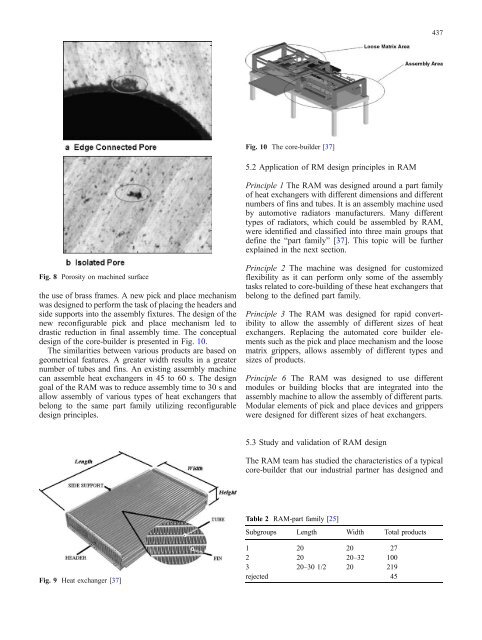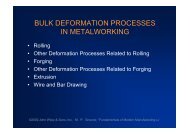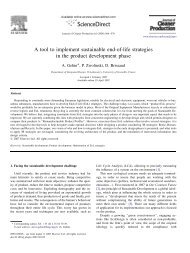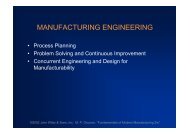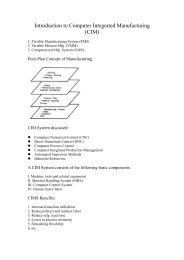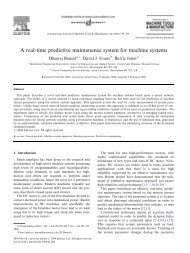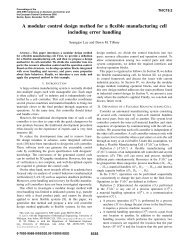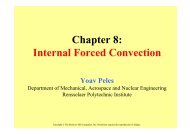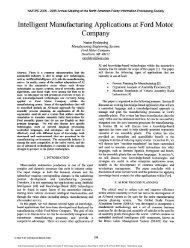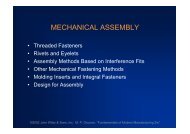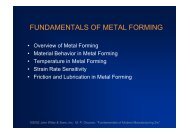437Fig. 10 The core-builder [37]5.2 Application <strong>of</strong> RM design <strong>principles</strong> in RAMPrinciple 1 The RAM was designed around a part family<strong>of</strong> heat exchangers with different dimensions and differentnumbers <strong>of</strong> fins and tubes. It is an assembly machine usedby automotive radiators manufacturers. Many differenttypes <strong>of</strong> radiators, which could be assembled by RAM,were identified and classified into three main groups thatdefine the “part family” [37]. This topic will be furtherexplained in the next section.Fig. 8 Porosity on machined surfacethe use <strong>of</strong> brass frames. A new pick and place mechanismwas designed to perform the task <strong>of</strong> placing the headers andside supports into the assembly fixtures. The design <strong>of</strong> thenew <strong>reconfigurable</strong> pick and place mechanism led todrastic reduction in final assembly time. The conceptualdesign <strong>of</strong> the core-builder is presented in Fig. 10.The similarities between various products are based ongeometrical features. A greater width results in a greaternumber <strong>of</strong> tubes and fins. An existing assembly machinecan assemble heat exchangers in 45 to 60 s. The designgoal <strong>of</strong> the RAM was to reduce assembly time to 30 s andallow assembly <strong>of</strong> various types <strong>of</strong> heat exchangers thatbelong to the same part family utilizing <strong>reconfigurable</strong>design <strong>principles</strong>.Principle 2 The machine was designed for customizedflexibility as it can perform only some <strong>of</strong> the assemblytasks related to core-building <strong>of</strong> these heat exchangers thatbelong to the defined part family.Principle 3 The RAM was designed for rapid convertibilityto allow the assembly <strong>of</strong> different sizes <strong>of</strong> heatexchangers. Replacing the automated core builder elementssuch as the pick and place mechanism and the loosematrix grippers, allows assembly <strong>of</strong> different types andsizes <strong>of</strong> products.Principle 6 The RAM was designed to use differentmodules or building blocks that are integrated into theassembly machine to allow the assembly <strong>of</strong> different parts.Modular elements <strong>of</strong> pick and place devices and gripperswere designed for different sizes <strong>of</strong> heat exchangers.5.3 Study and validation <strong>of</strong> RAM designThe RAM team has studied the characteristics <strong>of</strong> a typicalcore-builder that our industrial partner has designed andTable 2 RAM-part family [25]Subgroups Length Width Total productsFig. 9 Heat exchanger [37]1 20 20 272 20 20–32 1003 20–30 1/2 20 219rejected 45
438built for its customers. The team investigated this corebuilder’sfunctionality and tried to understand its limitationsand improve them.The study led to the conclusion that the productivity <strong>of</strong>the existing core-builder is constrained by elevatedchangeover and cycle times. Therefore, the goal was tominimize changeover time and hence reduce the idle state<strong>of</strong> the system. The constraint to productivity formed by thechangeover time can be addressed effectively by makingthe machine <strong>reconfigurable</strong>. As previously stated, RMs arespecifically designed to handle changes within a partfamily. Their modular design significantly contributestowards the reduction in changeover time. The changeoversin RAM are reduced to the interchanging <strong>of</strong> modulesinstead <strong>of</strong> the many adjustments needed in the existingassembly <strong>machines</strong>, when assembling different products.The first step in the design <strong>of</strong> a RM is a clearidentification <strong>of</strong> the part family. Using our industrialpartner’s products catalog, 398 radiators were classifiedand grouped. Combinations <strong>of</strong> product features werestudied in order to establish a relationship between theproduct characteristics. The information for this studyconsisted <strong>of</strong> product features such as model, length, width,height, number <strong>of</strong> rows and car that uses it. Theserelationships were utilized to define part families dependingon the characteristics that are more imperative tomachine architecture. The study <strong>of</strong> these relationshipsconcluded that the length and the width are the mostimportant parameters that affect the reconfigurability <strong>of</strong> themachine to the greatest extent.As a result <strong>of</strong> this study [38], three main subgroupsdefine the RAM part family, and a few rejected productswere identified as listed in Table 2. With the newlystructured part family, the number <strong>of</strong> required modules hasreduced to three; each <strong>of</strong> them takes care <strong>of</strong> one sub group,whereas still more than 90% <strong>of</strong> the product range wascovered. If the design <strong>of</strong> the modules is based on this partfamily definition then the resulting machine will handlechanges within product sub group without requiringchangeover at all, and if the change is across a part familythen the changeover will be restricted to a change <strong>of</strong> amodule. Hence, extended changeover time that leads tolarge downtimes, can be avoided. The easy changes acrossthe part family represent a good example <strong>of</strong> design forconvertibility. The design <strong>principles</strong> and the study <strong>of</strong> RAMwere not validated experimentally since the machine wasnot built.6 Summary and conclusionsThis paper outlines the importance <strong>of</strong> design <strong>principles</strong> forRMs. Based on the design <strong>principles</strong> presented in thispaper, the ideas presented in the RMT and RIM patents [25,29] were realized. Each <strong>of</strong> the full-scale RMs wasexperimentally tested for the validation <strong>of</strong> reconfiguration<strong>principles</strong> as well as for sound functional performance. Theprototypes described in the paper currently serve asresearch platforms.The main contributions <strong>of</strong> this paper are as follows:– The RMS vision was refined into concrete machinedesign <strong>principles</strong> for the design <strong>of</strong> RMs that can beused in a manufacturing system.– The generality <strong>of</strong> application <strong>of</strong> these <strong>principles</strong> wasdemonstrated in various manufacturing domains suchas machining, assembly and metrology.– The importance <strong>of</strong> the aforementioned design <strong>principles</strong>was validated for RMs.– Studies that demonstrate reconfigurability and goodperformance <strong>of</strong> the RMs that used the design <strong>principles</strong>for RMs were presented.The conclusions <strong>of</strong> our study are as follows:– RMs represent a new class <strong>of</strong> <strong>machines</strong> that aredesigned mainly for high-volume production applications.They bridge the gap between the flexible<strong>machines</strong> and the dedicated <strong>machines</strong>.– Not all design <strong>principles</strong> presented in this paper mustbe reflected in the design <strong>of</strong> each specific RM.However, the principle <strong>of</strong> a machine that is designedaround a part family is a necessary condition andshould be reflected in the design.– The design <strong>principles</strong> were demonstrated in the design<strong>of</strong> <strong>reconfigurable</strong> machining, inspection and assembly<strong>machines</strong>; however, this philosophy is general and maybe applied to other domains <strong>of</strong> machine design.– The design <strong>principles</strong> <strong>of</strong> RMs and RMS follow asimilar philosophy.– RMs enable production <strong>of</strong> different products thatbelong to the same part family by allowing rapidand efficient pre-designed changes <strong>of</strong> a machine’sconfiguration.– The design <strong>principles</strong> <strong>of</strong> RMs are focused mainly onthe functionality <strong>of</strong> these <strong>machines</strong> and are importantin the phase <strong>of</strong> conceptual design. The detailed design<strong>of</strong> a RM follows concepts similar to any other machinedesign.– The suggested design <strong>principles</strong> do not contradict anytraditional design <strong>principles</strong> related to the goodpractice <strong>of</strong> machine design.Acknowledgements The author would like to thank Pr<strong>of</strong>. Y. Korenfor his RMS vision and his remarks to this paper and to the teams <strong>of</strong>researchers and graduate students who participated in the RMT, RIMand RAM projects. The author would like to thank V. Srivatsan, J.Duphia and Dr. P. Spicer for their feedback and remarks to this paper.The author also gratefully acknowledges the financial support <strong>of</strong> theNSF Engineering Research Center for Reconfigurable MachiningSystems (NSF Grant EEC95-92125) at the University <strong>of</strong> Michigan.References1. Mehrabi MG, Ulsoy AG, Koren Y (2000) Reconfigurablemanufacturing systems: key to future manufacturing. J IntellManuf 11(4):403–4192. Altiok T (1996) Analysis <strong>of</strong> manufacturing systems. Springer,Berlin Heidelberg New York


